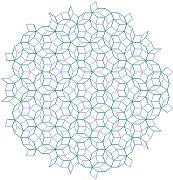Medieval Islamic tilers
During his time working as a PhD student in Harvard University's Physics department Peter J. Lu realised there was a link between medieval Islamic tilers and a discovery by the mathematician Roger Penrose in the 1970s. An article in the New Scientist magazine, dated 3rd March 2007 explained that this meant Islamic tilers were hundreds of years ahead of their time.
Question 1 of 1
Create a summary of Peter Lu's findings:
Penrose tiles
Classic Penrose tiles consist of two rhombi with angles 72 and 36 degrees.
The edges of the rhombi are all of equal length.
![]()
If you follow a few strict rules about how to place them together, you'll wind up with (= end up with) an aperiodic pattern. This means that no section of the pattern will be repeated as a unit.
Penrose tiling
"Now that I am able to visualize five-dimensional space in my head, I've noticed that I get a lot of weird looks from priests and small children." Roger Penrose, Oxford University mathematician

To see the archway from the Darb-i Imam shrine in Isfahan, Iran


